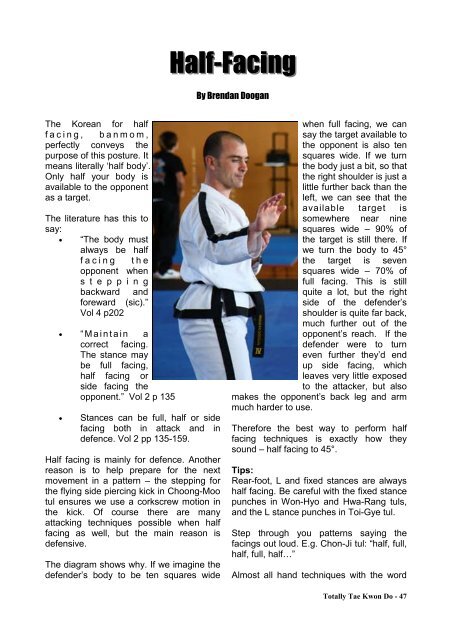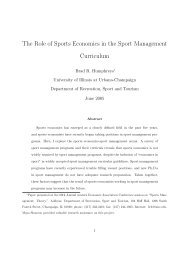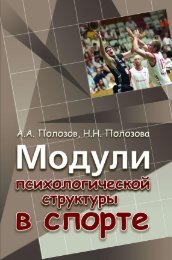Totally Tae Kwon Do Magazine - Issue 20 - Usadojo
Totally Tae Kwon Do Magazine - Issue 20 - Usadojo
Totally Tae Kwon Do Magazine - Issue 20 - Usadojo
You also want an ePaper? Increase the reach of your titles
YUMPU automatically turns print PDFs into web optimized ePapers that Google loves.
The Korean for half<br />
facing, banmom,<br />
perfectly conveys the<br />
purpose of this posture. It<br />
means literally ‘half body’.<br />
Only half your body is<br />
available to the opponent<br />
as a target.<br />
The literature has this to<br />
say:<br />
• “The body must<br />
always be half<br />
facing the<br />
opponent when<br />
s t e p p i n g<br />
backward and<br />
foreward (sic).”<br />
Vol 4 p<strong>20</strong>2<br />
• “Maintain a<br />
correct facing.<br />
The stance may<br />
be full facing,<br />
half facing or<br />
side facing the<br />
opponent.” Vol 2 p 135<br />
• Stances can be full, half or side<br />
facing both in attack and in<br />
defence. Vol 2 pp 135-159.<br />
Half facing is mainly for defence. Another<br />
reason is to help prepare for the next<br />
movement in a pattern – the stepping for<br />
the flying side piercing kick in Choong-Moo<br />
tul ensures we use a corkscrew motion in<br />
the kick. Of course there are many<br />
attacking techniques possible when half<br />
facing as well, but the main reason is<br />
defensive.<br />
The diagram shows why. If we imagine the<br />
defender’s body to be ten squares wide<br />
Half-Facing<br />
Half Facing<br />
By Brendan <strong>Do</strong>ogan<br />
when full facing, we can<br />
say the target available to<br />
the opponent is also ten<br />
squares wide. If we turn<br />
the body just a bit, so that<br />
the right shoulder is just a<br />
little further back than the<br />
left, we can see that the<br />
available target is<br />
somewhere near nine<br />
squares wide – 90% of<br />
the target is still there. If<br />
we turn the body to 45°<br />
the target is seven<br />
squares wide – 70% of<br />
full facing. This is still<br />
quite a lot, but the right<br />
side of the defender’s<br />
shoulder is quite far back,<br />
much further out of the<br />
opponent’s reach. If the<br />
defender were to turn<br />
even further they’d end<br />
up side facing, which<br />
leaves very little exposed<br />
to the attacker, but also<br />
makes the opponent’s back leg and arm<br />
much harder to use.<br />
Therefore the best way to perform half<br />
facing techniques is exactly how they<br />
sound – half facing to 45°.<br />
Tips:<br />
Rear-foot, L and fixed stances are always<br />
half facing. Be careful with the fixed stance<br />
punches in Won-Hyo and Hwa-Rang tuls,<br />
and the L stance punches in Toi-Gye tul.<br />
Step through you patterns saying the<br />
facings out loud. E.g. Chon-Ji tul: “half, full,<br />
half, full, half…”<br />
Almost all hand techniques with the word<br />
<strong>Totally</strong> <strong>Tae</strong> <strong>Kwon</strong> <strong>Do</strong> - 47

















